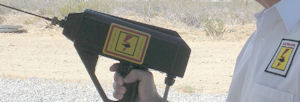 MOJAVE,CA—2014 is a red-letter year for Etex Ltd. It marks the 35th anniversary of its Electro-Gun, the unique control weapon that’s used successfully by pest management professionals (PMPs) to find and destroy drywood termites and other wood-boring insects.
MOJAVE,CA—2014 is a red-letter year for Etex Ltd. It marks the 35th anniversary of its Electro-Gun, the unique control weapon that’s used successfully by pest management professionals (PMPs) to find and destroy drywood termites and other wood-boring insects.
“Since 1979, our company has placed Electro-Guns with pest control companies across the USA as well as in Tahiti, Costa Rica, French Polynesia and Portugal,” says Susan Fortuna, Etex president. “We are firmly committed to continue serving the pest control industry.”
Fortuna is the daughter of the late Don Bondy, the man who founded Etex in Nevada after he, with the help of scientist Lucas Lawerance, invented and perfected the termite-killing device.
“Back in the 1970s, my dad was one of the pioneers of the green revolution. He believed there had to be a way to kill termites without using chemicals in a structure,” she says. “They began a serious R & D project designed to create a product that would be both safe and effective. The end result of their hard work and dedication was the Electro-Gun. It’s now recognized as a top alternative treatment for localized termite infestations.”
Fortuna cites extensive research, field-testing and innovations over the years as consistent proof that the Electro-Gun is a green, safe and effective tool that kills drywood termites while maintaining the structural integrity of treated buildings.
Leading entomologists, universities, world-renowned scientific research organizations and forensic science establishments have tested and validated it for safety, efficacy and structural integrity, she states.
“It can be used as a stand-alone treatment or in conjunction with one or more non-chemical treatments, borates or localized chemical treatments,” Fortuna adds. “Furthermore it works in harmony with all current detection devices and fits perfectly into IPM treatment programs.”
Electro-Gun’s technology combines high frequency, high voltage and very low current to overcome wood’s natural resistance to electrical current flow. The current penetrates wood and flows into the galleries and nests of drywood termites. A highly trained technician will target a known or suspected infestation, and then pan out from that area with a zigzag motion, while watching and listening to the equipment. When the electricity coming from the end of the probe reaches a termite gallery, the pitch or hum of the device will change and intensify as the electricity forms a straight line into the infestation. Most of the insects are killed instantly, and there is a delayed mortality to those that don’t get a direct hit.
Leave A Comment